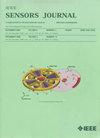Validation of an MEMS-Based Pressure Sensor System for Atrial Fibrillation Detection From Wrist and Finger
IF 4.3
2区 综合性期刊
Q1 ENGINEERING, ELECTRICAL & ELECTRONIC
引用次数: 0
Abstract
To address the unmet need for a low-cost, low-power wearable solution for continuous cardiovascular health monitoring, we developed and validated an atrial fibrillation (AF) detection algorithm using clinical data collected with a microelectromechanical system (MEMS)-based pressure sensor. This sensor system, consisting of a circuit board, capacitive digitizer, and three MEMS elements, was specifically designed for early detection of AF—a common cardiac arrhythmia that requires frequent screening. The proposed algorithm extracts seven AF-related features, derived from autocorrelation analysis, interbeat interval (IBI) measurements, and differential IBI (dIBI) analysis, including a novel mean distance of points in the Poincaré plot (MDPP) feature. Clinical validation was conducted using data from 53 participants across three datasets: 13 healthy volunteers (wrist), 20 postcardiac surgery sinus rhythm (SR) patients (wrist), and 20 patients with AF (wrist and finger). Leave-one-out cross-validation showed that logistic regression achieved an area under the receiver operating characteristic curve (AUROC) of 93.0% using the full feature set. Performance remained stable across segment lengths ranging from 10 to 120 s, supporting the algorithm’s suitability for continuous monitoring. Consistent performance across seven different classifiers (average AUROC 92.1%) further demonstrated the clinical applicability and generalizability of the approach for wearable-based AF screening. To assess robustness against motion artifacts, we introduced five types of synthetic noise, with the algorithm maintaining strong AF detection performance under these conditions. Finally, a systematic evaluation of sensor waveform shape and signal strength across SR and AF at both the wrist and finger sites demonstrates the potential of the sensor system for wearable AF screening.基于mems的手腕和手指心房颤动压力传感器系统的验证
为了解决对低成本、低功耗可穿戴解决方案持续心血管健康监测的需求,我们开发并验证了一种心房颤动(AF)检测算法,该算法使用基于微机电系统(MEMS)的压力传感器收集的临床数据。该传感器系统由电路板、电容数字化仪和三个MEMS元件组成,专为早期检测af(一种需要频繁筛查的常见心律失常)而设计。该算法从自相关分析、拍间间隔(IBI)测量和差分IBI (dIBI)分析中提取出7个af相关特征,包括一种新的poincar图中点的平均距离(MDPP)特征。临床验证使用来自三个数据集的53名参与者的数据进行:13名健康志愿者(手腕),20名心脏手术后窦性心律(SR)患者(手腕)和20名房颤患者(手腕和手指)。留一交叉验证表明,使用完整的特征集,逻辑回归在接收者工作特征曲线(AUROC)下的面积达到93.0%。在10到120秒的段长度范围内,性能保持稳定,支持算法适合连续监测。7种不同分类器的一致表现(平均AUROC为92.1%)进一步证明了该方法在基于可穿戴设备的房颤筛查中的临床适用性和普遍性。为了评估对运动伪像的鲁棒性,我们引入了五种类型的合成噪声,该算法在这些条件下保持了强大的自动对焦检测性能。最后,系统地评估了手腕和手指部位SR和AF的传感器波形形状和信号强度,证明了传感器系统在可穿戴AF筛查方面的潜力。
本文章由计算机程序翻译,如有差异,请以英文原文为准。
求助全文
约1分钟内获得全文
求助全文
来源期刊

IEEE Sensors Journal
工程技术-工程:电子与电气
CiteScore
7.70
自引率
14.00%
发文量
2058
审稿时长
5.2 months
期刊介绍:
The fields of interest of the IEEE Sensors Journal are the theory, design , fabrication, manufacturing and applications of devices for sensing and transducing physical, chemical and biological phenomena, with emphasis on the electronics and physics aspect of sensors and integrated sensors-actuators. IEEE Sensors Journal deals with the following:
-Sensor Phenomenology, Modelling, and Evaluation
-Sensor Materials, Processing, and Fabrication
-Chemical and Gas Sensors
-Microfluidics and Biosensors
-Optical Sensors
-Physical Sensors: Temperature, Mechanical, Magnetic, and others
-Acoustic and Ultrasonic Sensors
-Sensor Packaging
-Sensor Networks
-Sensor Applications
-Sensor Systems: Signals, Processing, and Interfaces
-Actuators and Sensor Power Systems
-Sensor Signal Processing for high precision and stability (amplification, filtering, linearization, modulation/demodulation) and under harsh conditions (EMC, radiation, humidity, temperature); energy consumption/harvesting
-Sensor Data Processing (soft computing with sensor data, e.g., pattern recognition, machine learning, evolutionary computation; sensor data fusion, processing of wave e.g., electromagnetic and acoustic; and non-wave, e.g., chemical, gravity, particle, thermal, radiative and non-radiative sensor data, detection, estimation and classification based on sensor data)
-Sensors in Industrial Practice
 求助内容:
求助内容: 应助结果提醒方式:
应助结果提醒方式:


